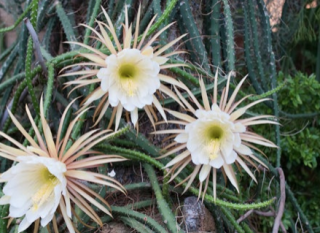Endless Forms
Posted in Garden News on July 19 2019, by Plant Talk
Matthew C. Pace, Ph.D., is an Assistant Curator at The New York Botanical Garden.
 Focusing on some of Earth’s most interesting and endangered plant species, NYBG is leading a network of 17 collaborating U.S. research institutions that will digitize more than two million preserved plant specimens over the next three years to make this invaluable scientific resource easily available online to plant and conservation researchers, students, and the general public.
Focusing on some of Earth’s most interesting and endangered plant species, NYBG is leading a network of 17 collaborating U.S. research institutions that will digitize more than two million preserved plant specimens over the next three years to make this invaluable scientific resource easily available online to plant and conservation researchers, students, and the general public.
The project, “Digitizing ‘endless forms’: Facilitating Research on Imperiled Plants with Extreme Morphologies,” will concentrate on 15 plant families containing species that are carnivorous or succulent or that grow on other plants, known as epiphytes. Among the several hundred thousand species included in the project are such iconic and unusual plants as the Venus’s flytrap, the giant saguaro cactus, and the leafless ghost orchid of southern Florida. All of the species in the project display, in one way or another, remarkably varied types of adaptations that allow them to grow in extreme environments, including deserts, tropical rain forests, and nutrient-poor bogs. Many of these plants can be challenging to study in the wild and confront elevated conservation threats in the face of rapid environmental change.
The “Endless Forms” project takes its name from the conclusion of Charles Darwin’s landmark 1859 work about evolution, On the Origin of Species: “from so simple a beginning endless forms most beautiful and most wonderful have been, and are being, evolved.”
“Endless Forms” is supported by a National Science Foundation grant of nearly $2.8 million. The principal investigators leading the project are Matthew C. Pace, Ph.D., Assistant Curator of NYBG’s William and Lynda Steere Herbarium, and Barbara M. Thiers, Ph.D., Vice President and the Patricia K. Holmgren Director of the Steere Herbarium. Among the other collaborating institutions are the Missouri Botanical Garden, the California Academy of Sciences, the University of California–Berkeley, Harvard University, and the Field Museum of Natural History in Chicago.
The Steere Herbarium holds an estimated 280,000 carnivorous, succulent, and epiphytic specimens, one of the largest collections in the world. Many of these specimens belong to critically endangered species collected over the past three centuries, often from areas where it is now challenging, if not impossible, to conduct new field research. Because of this, herbarium specimens are an unparalleled window on the past, as well as a critical means for understanding the future of biodiversity.
This article originally appeared as part of the Spring-Summer 2019 issue of Garden News, NYBG’s seasonal newsletter. For further reading, view the issue online and discover a sampling of stories about current programs and undertaking at the Garden.

